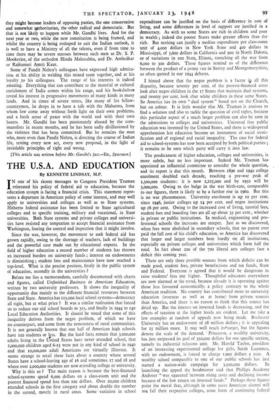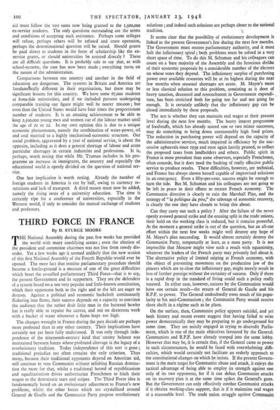THE U.S.A. AND EDUCATION
By KENNETH LINDSAY, M.P.
N one of his recent messages to Congress President Truman I reiterated his policy of federal aid to education, because the education system is facing a financial crisis. This statement repre- sents a departure in American policy of some interest, and may well apply to universities and colleges as well as to State systems. Hitherto federal assistance has been limited to State agricultural colleges and to specific training, military and vocational, in State universities. Both State systems and private colleges and universi- ties have resisted any temptation to accept financial assistance from Washington, fearing the control and inspection that it might involve.
Since- the war, however, the movement to seek federal aid has grown rapidly, owing to the shortage of teachers, lack of buildings and the powerful case made out by educational experts. In the field of higher education a record number of students has thrown an increased burden on university funds ; interest on endowments is diminishing ; student fees and maintenance have now reached a top-level. What is the precise position, firstly in the public system of education, secondly in the universities ?
Before me lies a memorandum, carefully documented with charts and figures, called Unfinished Business in American Education, written by two university professors. It shows the inequality of opportunity due mainly to the different financial resources between State and. State. America has 115,000 local school systems—democracy all right, but at what price ? It was a similar realisation that forced us to reduce our old school boards to 315, and finally in 1944 to 140 Local Education Authorities. It should be noted that some of this inequality derives from the negro problem, of which we have no counterpart, and some from the remoteness of rural communities. It is not generally known that one half of American high schools have too students or less. But the hard facts remain that 3,000,000 adults living in the United States have never attended school, that 2,000,000 children aged 6-15 were not in any kind of school in 1940 and that io,000,000 adult Americans are virtually illiterate. It seems strange to retail these facts about a country where several States have a school-leaving age of 16 and sometimes 17 and 18 and where over 2,000,000 students are now attending college or university.
Why is this so ? The main reason is because the best-financed school-systems spend 6,000 dollars on a class-room unit and the poorest financed spend less than too dollars. Over 20,000 children attended schools in the first category and about double the number in the second, mostly in rural areas. Some • variation in school expenditure can be justified on the basis of difference in cost of living, and some differences in level of support are justified in a democracy. As with us some States are rich in children and poor in wealth ; indeed the poorer States make greater efforts than the rich. But nothing can justify a median expenditure per class-room unit of 4,000 dollars in New York State and 400 dollars in Mississippi, of 3,600 dollars in California and goo in North Dakota, or of variations in one State, Illinois, stretching all the way from 6,000 to 300 dollars. These figures remind us of the difference between the product of a penny rate in Surrey and Montgomeryshire, so often quoted in our 1944 debates.
I hinted above that the negro problem is a factor in all this disparity, because seventy per cent, of the poorest-financed areas look after negro children in the 17 States that maintain dual systems, and twenty per cent. look after white children in these same States. So America has its own " dual system " based not on the Church, but on colour. It is little wonder that Mr. Truman is anxious to find a solution and also to tackle the question of civil rights, because this particular aspect of a much larger problem can also be seen in the admissions to colleges and universities. Universal free public education was invented by the United States, and there is widespread apprehension lest education become an instrument of social strati- fication and of regional and racial inequality. The case for federal aid to school-systems has now been accepted by both political parties ; it remains to be seen which party will carry it into law.
The predicament of higher education, colleges and universities, is more subtle, but no less important. Indeed Mr. Truman has appointed an influential committee to consider the whole question, and its report is due this month. Between 1890 and 194o college enrolment doubled each decade, reaching a pre-war peak of 1,5oo,000 students: it is now 2,225,000 and by 1950 will be 3,000,000. Owing to the bulge in the war birth-rate, comparable to our figures, there is likely to be a further rise in 1960. But this is no war phenomenon. University enrolment is up ro per cent. since 1946, junior colleges up 14 per cent. and negro institutions up 26 per cent. Owing to the increased cost of living, tutorial fees, student fees and boarding fees are all up about 35 per cent., whether in private or public institutions. In medical, engineering and pro- fessional schools the increases are steeper. Just as we discovered, when fees were abolished in secondary schools, that no parent ever paid the full cost of his child's education, so America has discovered that larger and larger numbers bear hardly on all institutions, especially on private colleges and universities which form half the total. In fact about 200 of the 700 liberal arts colleges face a deficit this coming year.
There are only three possible sources from which deficits can be made good, student fees, private benefactions and tax funds, State and Federal. Everyone is agreed that it would be dangerous to raise students' fees any higher. Thoughtful educators everywhere are now alarmed at the trend, because already it is operating against those less favoured economically, a policy contrary to the whole American tradition. No country has contributed more to university education (overseas as well as at home) from private sources than America, and there is no reason to think that this source has dried up. But the interest on invested funds is decreasing, and the effects of taxation at the higher levels are evident. Let me take a few examples at random of appeals now being made. Rochester University has an endowment of 58 million dollars ; it is appealing for 25 million more. It may well reach its' target, but the figures denote the scale of the demand. /Princeton, a wealthy university, has just surpassed its goal of 350,000 dollars for one specific section, namely its industrial relations unit. Mr. Harold Taylor, president of an interesting experimental college for girls, Sarah Laurence, with no endowment, is forced to charge 1,900 dollars a year. A wealthy school comparable to one of our public schools has just started a nation-wide campaign for 3,500,000 dollars. In launching the appeal the headmaster said that Phillips Academy Andover " was squeezed between rising costs and declining income because of the low return on invested funds." Perhaps these figures point the moral that, although in some cases American alumni will not fail their respective colleges, some form of continuing federal
aid must follow the vast sums now being granted to the 1,5oo,00o ex-service students. The only questions outstanding are the terms and conditions of accepting such assistance. Perhaps some colleges will refuse, perhaps others will be refused and cease operation, perhaps the denominational question will be raised. Should grants be paid direct to students in the form of scholarship like the ex- service grants, or should universities be assisted directly ? These are all difficult questions. It is probably safe to say that, as with school-systems, the case has now been made ; everything turns on the nature of the administration. _
Comparisons between one country and another in the field of education are dangerous. The systems in Britain and America are fundamentally different in their organisation, but there may be significant lessons for this country. We have some 67,000 students at bona-fide universities, and if we included persons undergoing comparable training our figure might well be nearer 200,000 ; but even then the United States would have four times the proportionate number of students. It is an amazing achievement to be able to keep 2,500,000 young men and women out of ,the labour market until the age of 21 or 22. In my own opinion this is due to a unique economic phenomenon, namely the combination of water-power, oil and coal married to a highly mechanised economic structure. Our social problem, aggravated by a year of national service, is about the opposite, including as it does a general shortage of labour and acute particular shortages in certain industries and professions. It is, perhaps, worth noting that while Mr. Truman includes in his pro- gramme an increase in immigrants, the country and especially the educational world is openly divided on the question of national ser- vice.
One last implication is worth noting. Already the number of foreign students in America is cut by half, owing to currency re- strictions and lack of transport. A third reason must now be added, namely the rising costs of a university education. The time is certainly ripe for a conference of universities, especially in the Western world, if only to consider the mutual exchange of students and professors.































 Previous page
Previous page